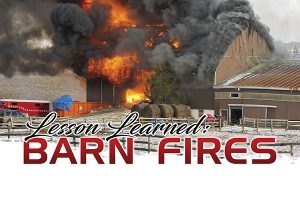
Lesson Learned: Barn Fires
Click here to read the complete article
232 – November/December, 2023
Within almost 30 days at the beginning of 2022, two Midwestern farms experienced every barn owner’s absolute worst nightmare.
On January 6, 2022, Springcliff Farm in Martinsville, Indiana, lost 26 Thoroughbred and Quarter Horse broodmares–ready to foal–when the Hoosier Heritage farm went up in flames in the early morning hours.
On February 5, 2022, Kristy Doyle’s barn in Ellsworth, Illinois, burnt down on a particularly frigid winter night, killing 13 Quarter and Paint Horses.
According to the Animal Welfare Institute, 113 deadly barn fires occurred in 2021. Between 2018 and 2021, the average number of animals killed in barn fires each year topped 748,000 animals (this includes chickens, cows, pigs, horses, llamas, etc.).
“You never want it to happen to anyone,” says Doyle.
“I was living in an absolute nightmare,” says Christine Cagle, owner of Springcliff Farm.
There have been many articles written about what to do to prevent a fire at your barn. Yet, there are still many tragic stories of horses being lost to flames and barn owners saying they don’t know what caused the fires.
“The real key to mitigating the damage from all of these disasters is having a plan that is enacted immediately; and it has to be done before the fire department reaches your farm,” says Rebecca Husted, lead instructor with Technical Large Animal Emergency Response.
Husted has heard all the stories and seen all the tragedies. She studies the notes of every barn fire she hears about and teaches fire departments and barn owners the right things to do to help prevent bigger tragedies.
Early Detection
Click here to read the complete article
232 – November/December, 2023

Recently Added
- Elevate your Equine Affaire Experience with the New Trail Guide April 3, 2025
- New All-Around Awards Added to 2025 APHA World Show Lineup April 3, 2025
- EC Photo of the Day – Shouldv Known Better April 3, 2025
- More Around the Rings – 2025 Palmetto PHC Carolina Cash Show April 2, 2025
- Lynn Palm Western Dressage Fund Provides Educational Grants for Group Education April 2, 2025
- Two Martinganza Crew Members Honored at 2025 AQHA Convention April 2, 2025
- EC Photo of the Day – Count On Me April 2, 2025
- A New Hope For Treating Laminitis—Methylated Tirilazad April 2, 2025
- Free Official AQHA Pedigrees Now Available April 1, 2025
- New Equine Surgeons at UC Davis April 1, 2025
Archives
Sign In
Equine Chronicle ® All Rights Reserved. Copyright © 2025
4727 NW 80th Ave. • Ocala, FL 34482 • 352 369 1104 • FAX 352 369 1521
Privacy Policy | Questions, please contact The Equine Chronicle
-









